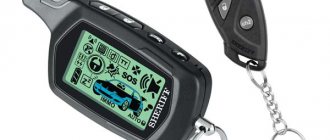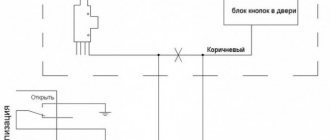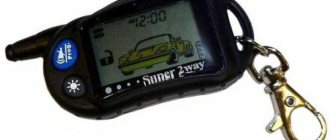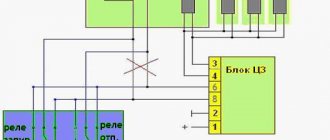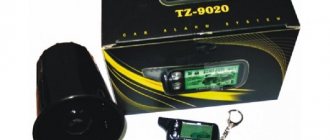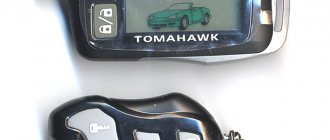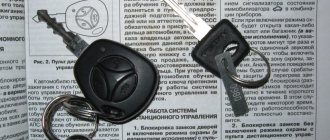Sheriff security systems, if the number 1000 or higher is indicated in the name, are always equipped with an automatic start option. Judging by the reviews, for most owners all options work reliably, but problems usually arise with autostart. Any Sheriff car alarm is a rather complex programmable device capable of tracking and remembering events perceived through different channels and inputs. Some people, for example, connect signal inputs directly to ground, and then wonder why they cannot autostart. It was decided to list all such errors in the text. Happy reading.
The alarm must be used correctly
Alarm units belonging to the Sheriff brand and equipped with auto start have a gearbox selection loop. It is easy to notice that the statement is not true for all devices of the family in question - sometimes software settings are used. In a car with a manual transmission, the owner must perform certain actions, and only then will autostart be allowed. All connections, moreover, are made according to the basic diagram, which is true for any car.
We hope everything is clear here.
Each Sheriff alarm key fob is equipped with a key that allows you to immediately perform a remote start. For most models, this will be the Ch2 key, which is pressed twice. By the way, the sequence discussed above is suitable for a car with a manual transmission. But a car with an automatic transmission can also be equipped with autostart. The Sheriff 1000 car alarm, for example, in the options table has a special setting SF14, which allows you to select the type of gearbox. Initially, the value is set to “1”, that is, “Manual gearbox”.
The owner of a car with an automatic transmission is required to perform the same actions as listed in the text above. But at the same time, as stated in the instructions, the engine stops immediately, and you can leave the cabin at any time.
Reprogramming the remote control
Adaptation of the remote alarm device 725 and zx 750 is not always carried out due to its breakdown. When you buy a used car, the former owner gives you two key fobs. There is no complete certainty that he did not keep one for himself. After all, the basic kit includes four communicators. In this case, be sure to reflash the key fobs.
- Turn the ignition key to the first position.
- Press Valet three times quickly. The siren beeped.
- Click on the keychain “Close”. The CHIRPS will sound again.
- Click on the second pager “Arming the car”. The siren will beep again.
- Turn off the ignition. Previously used remote controls will be erased from the anti-theft system's memory.
It is easy to flash the Sheriff communicator yourself, just follow the instructions carefully and you will succeed.
See how to attach a new key fob to the Mongoose alarm system.
About connection and programming
Let's look at the part of the diagram where the “power connector” is shown:
The “red-blue” cord receives power for the “dimensions”, and then it is switched inside the main unit. And the current flowing through the “red” wire is switched by 4 built-in relays (see figure). The standard circuit protection with the “red” wire should be rated at 30 Amps or less. Everyone knows how to connect every cable except the “purple” one. But it is useless to connect the “purple cord” to the “15/2” terminal, if we talk about standard locks. Options for its connection are discussed below.
Let's understand the purpose of the 6th contact
The text of the instructions indicates that the “IGN3” contact can either duplicate the “IGN1” terminal, or it is used to control additional equipment. The latter in this case includes:
- Starter protection line: current enters it after the engine starts, and the line breaks simultaneously with the ignition being turned off. Note that when starting from the key, the line remains open.
- From the “IGN3” terminal you can remove the voltage used to emulate pressing the brake or clutch. The option is in demand if installations with a “START/STOP” button are equipped with autostart.
- The “IGN3” wire can receive a pulse that coincides in time with the end of the motor operation in the security mode. The pulse duration is controlled by software.
You will need to choose one from several algorithms. What is done even before connecting the wire itself, but after installing the signaling in the car.
If there is a terminal that duplicates the “IGN1” contact, it must be used to control the crawler, which allows you to “deceive” the standard immobilizer and start the engine. This statement is common, but in this case it is not true. The ZX-1070 alarm, for example, is equipped with a separate output, indicated in the first diagram by the abbreviation “Immo”. By the way, the algorithm can be configured in different ways, and in the instructions it is designated as “CH4”.
For anyone who doubts what was said above, here is a screenshot of the basic guide.
Let us note once again: in the diagram, the crawler’s output is indicated by the abbreviation “Immo”. In the table, the same wire is called the “CH4 line”.
Typical user mistakes
The design of the Sheriff system, equipped with auto-start, provides for the following protection: if the engine was started automatically, then switching to alarm mode will result in its shutdown. Everything looks logical here, but now let’s look at another situation when theft protection is not active. In the “disarmed” mode, the engine can be started at any time. But if you open the door when the engine is already turned off by the system, this feature will be canceled. The latter is true for cars with a manual transmission, and bypassing this protection is easy:
- After unlocking the door, the engine is started “with the key”;
- The ignition is turned off, the “correct exit” procedure is repeated again (see above).
This is what the features of Sheriff brand alarms look like.
The system stores error codes caused by the owner and related to autostart in its memory. The decoding of all codes is given in the basic instructions:
To find out what the last error code is, you need to switch the system to programming mode. We are talking about programming options related only to autorun and not related to protection functions. How to enable this mode is described in the manufacturer's instructions. Here you should read the next chapter.
Software system setup
So, let all connections be made according to the basic diagram. Cord “6” coming out of the “power terminal block” can remain free. Let's open the instructions and see how to program options related to autorun:
- The system is disarmed and the ignition is turned on;
- Within 5 seconds, the Valet service button is pressed 3 times;
- After the sound signal, the Valet button is pressed again;
- The ignition is turned off within 5 seconds, and after the sound signals are turned on again.
How to connect?
Let's consider connecting a 12-pin connector using the example of model 2500:
- The white contact is pulsed and is used to connect the turning lights of the car. The wire is connected to the positive output.
- The red contact must be protected by a 15 Amp fuse. This output is necessary to provide power to the built-in power circuits, we are talking about the side lights of the car.
- The red contact with the white stripe must be protected with a 5 Amp fuse. This output is necessary to provide power to the main electrical circuits of the anti-theft installation.
- The black and white output is used to provide power to the siren. The white wire is connected to the black strip of the red contact of the siren. The black output connected to the siren must be connected to ground, that is, the body of the car.
- The black contact is used for the power supply input; this element is connected to ground. It is important not to confuse this wiring with the black contact of the antenna adapter. The latter is connected to the control module separately.
- The dark blue output is the contact of the second CH2 channel. This element is a low current resistor contact and should be used to activate an external relay. This output must not be connected to the luggage lock opening circuit or to the input of the remote start elements, otherwise the central unit may be damaged. The contact is connected to output number 86 of the relay.
- The dark green contact is used to connect the negative polarity limit switches of the tailgate and hood. It is important that the switches are connected to ground, that is, the ground of the machine.
- The purple contact is used as an input for connecting door limit switches with positive polarity. The output is connected to one of the limit switches on the doors. It is not necessary to connect it to all elements, since on most machines the switches are connected in parallel. If the car uses limit switches with negative polarity, then there is no need to connect the purple contact to them.
- The brown output is used as an input for connecting door limit switches with negative polarity.
- The yellow contact is an input for connecting the ignition electrical circuits. This output must be connected to the electrical circuit of the lock that receives 12 Volts, provided that the key is located in the ignition or starter position. Before connecting, you need to make sure that the standard electrical circuit of the machine is not supplied with power if the key is in the off position.
- Orange output – pulse contact with negative polarity. This circuit is used to control the operation of the starter disable relay. The output must be connected to relay contact number 86. To do this, connect contact 85 from the relay to the car’s ignition circuit, which receives 12 Volt power if the key is installed in the lock in the ignition or starter position.
Connection diagram
“Sheriff” with auto start and connection to Mitsubishi
Sheriff car alarms (the term “security systems” is of little use to them by modern standards) is a classic example of budget devices in the lower price segment, which are purchased solely on the principle “so that the doors open and the LED blinks, maybe they won’t get in”). Frankly outdated models continue to be supplied under this brand: for example, the Sheriff APS-2500 alarm system still uses the Keeloq algorithm, which did not protect against code grabbers even ten years ago. In more “fresh” and complex systems, instead of real technical improvement, cheap marketing tricks are used, misleading the average buyer.
As an example, the instructions for the “Sheriff ZX-1090 PRO” alarm system indicate the use of a certain DISARM DIALOG code in it. From the buyer's point of view, it is logical to assume that we are talking about dialog code, which is now considered to be maximally protected from intellectual hacking. In fact, the dialogue code (of dubious complexity) is used here only in the main key fob: for normal use of the entire set it has to be turned off (!), otherwise the additional key fob will not disarm the car.
It is impossible to talk about a full-fledged dialogue code at the level of StarLine systems (in the design of Sheriff key fobs there is obvious mimicry with the second generation StarLine systems) or Pandora.
Only the latest Sheriff models like the ZX-1095, which provide for working with a CAN bus and validating a transponder tag, can be called more or less meeting modern requirements. However, it is still equipped with an additional key fob without dialog code support, and to fully use both key fobs you have to switch to a primitive dynamic code. Thus, Sheriff cannot provide any significant competition in the middle price range, and in fact, the main sales of this brand fall on the most budget lines.
Two-way models
The processor device of such anti-theft systems communicates with the key fob using a secure channel. The owner regularly receives messages about the condition of the vehicle. The data is reflected on the display of the control panel.
Sheriff ZX-945 and ZX-1090
The ZX-945 feedback alarm has the following features:
- interactive signal coding, providing reliable protection against hacking;
- high range of the key fob (signals are received at a distance of up to 2 km);
- processor unit equipped with 4 communication channels;
- the presence of a liquid crystal screen in the main communicator;
- 2 security modes: active and passive;
- possibility of connecting 2 engine blockers (devices prevent criminals from starting the engine).
Commands from the ZX-1090 alarm key fob can be issued from a distance of 1000 m. The range of the communicator in receiving mode is 2200 m. The spare pager operates at a distance of up to 50 m. Dynamic dialogue coding prevents intruders from intercepting the signal.
Sheriff ZX-1070 and ZX-940
Sheriff ZX-1070 is equipped with a feedback function and an engine auto-start module. The system reliably protects the vehicle from theft, damage and evacuation attempts. An auto-start alarm can be configured so that it starts the engine on a timer or at certain intervals. Other useful functions of the anti-theft system include:
- dynamic signal coding;
- active and passive security modes;
- separate control of activation and deactivation of protective functions;
- passive engine blocking;
- using a displacement sensor.
The Sheriff ZX-940 anti-theft system is equipped with 4 service channels. There is a two-way communication function. The user sees messages about the vehicle's status on the key fob screen. The driver can remotely adjust the seat position, engine start and security system lights.
Overview of models and operating and installation manuals
Sheriff APS-2500
An extremely primitive system without feedback, which is controlled by two key fobs with minimal functionality: one button controls arming/disarming, the second activates an additional channel, and in combination with the first, it implements arming with disabling sensors or silent mode.
This “Sheriff” alarm system can actually be considered a radio-controlled central locking module with a tiny share of security functions. With a standard installation, it is not at all difficult to disable it if the machine is hacked. Just look in the instructions to see how to disable the system without using a key fob:
- Open the door with the key.
- Turn on the ignition.
- Press the Valet button within an interval of no more than 10 seconds.
Therefore, for the owner, setting a secret code is a mandatory measure to ensure at least some security. Here its length is fixed, two numbers from 1 to 9, which theoretically gives 81 different combinations. However, the instructions prohibit choosing the number 3 as the first digit of the code, which reduces the number of combinations to 72.
To set a secret code, you need to disarm the car:
- Turn on-off-on the ignition.
- Dial the first digit using the Valet button.
- Turn off, then turn on the ignition again.
- Dial the second digit.
- Turn off and turn on the ignition.
- After waiting for a short signal from the siren, turn off the ignition again.
But in order for the alarm to start working with a secret code, you need to activate the corresponding function:
- After disarming the car, turn on the ignition.
- No later than 3 seconds later, press Valet three times (this is why you cannot use 3 in the first digit of the secret code).
- Turn off and turn on the ignition.
- Press Valet 9 times, going to the F9 function.
- Press the main key fob button - the system will give two siren signals, indicating that the F9 function has been switched to value 2 (secret code).
The procedure for disabling the security status using a secret code is the same as entering it.
Installation instructions for alarm system Sheriff APS-2500
Sheriff APS-2600
A minimally modernized version of the APS-2500, which now has arming and disarming buttons on the key fob of the same design.
Installation instructions for alarm system Sheriff APS-2600
Sheriff APS-35 PRO
The system differs from the APS-2500 model only in the updated design of the key fobs, where the arming and disarming buttons are separated, and the presence of a built-in power relay for an additional channel in addition to the low-current output. The remaining capabilities and level of protection of this alarm system are in no way superior to the APS-2500. True, the restriction on the first digit of the secret code has been removed, which, however, cannot be called a serious achievement.
Installation instructions for alarm system Sheriff APS-35 PRO
Sheriff ZX-750
Two-way communication system on the main key fob. Operates with wideband modulation on the 433 MHz band without using any form of dialog code. In modern urban conditions, this reduces the radius of reliable communication, and you can’t count on protection from code grabbers even more so. The only more or less relevant protection function is the control of a digital blocking relay, which, however, is not included in the package.
Functional features and capabilities of the system
Models of Sheriff car security systems may have different characteristics and functions.
Let's look at the features characteristic of all Sheriff anti-theft systems:
- “Signalka” Sheriff can operate effectively over a wide temperature range. The manufacturer especially recommends using the anti-theft system for residents of northern regions.
- Possibility of monitoring the condition of the machine remotely. Thanks to the key fob with feedback, there is a function to notify the car owner. If one of the security zones is triggered, the remote control display will display information about which area was affected.
- Remote vehicle control. Depending on the modification of the anti-theft installation, the system may have different engine starting options. In addition to the standard settings, you can change the activation time of the power unit and turn on the interior lighting function. The car owner can reprogram the remote control and change the starting configuration of the engine.
- The anti-theft system works with a security code. Signals are transmitted between the control unit and the remote control via a secure channel. According to the manufacturer, it is impossible to hack it with electronic scanners and grabbers.
- Easy to install alarm system. This is achieved as a result of the minimum number of electronic devices and equipment that is included in the kit. Thanks to the steps described in detail in the instructions, you can connect the anti-theft installation at home.
- Almost all models of modern Sheriff alarms allow you to control the operation of electric windows. This is only possible if there are door closers.
- Closing and opening of doors is carried out remotely. When the car is disarmed, the alarm disables the door and trunk locking.
- If necessary, the car owner can activate the silent arming mode. Its fundamental difference is that when the alarm is turned on and off, the siren will not sound.
- You can configure the alarm so that the protective mode will be activated automatically if the driver leaves the car or closes the last door.
- Modern models of anti-theft installations are equipped with a tag. It is used to identify the car owner as a result of data received from the key fob via the communication channel.
- You can set the doors to close automatically when the car starts moving.
- It is allowed to arm the car when the power unit is running. This option is most relevant if the driver plans to leave the car for a short time.
- There is a “panic” mode. When activated, the siren and vehicle lights are activated. The mode is designed to deter potential criminals.
- If the alarm functionality allows, you can configure the anti-theft installation to be disabled using a secret password or switch. The driver must know the code; it is programmed when installing and configuring the “signaling”.
- There is an option to notify the car owner about the condition of the car when using the immobilizer.
The user “Kolya Kolya” told how to link the Sheriff alarm control panel.
Main characteristics and advantages of Sheriff alarms
The company produces a fairly wide range of security systems, the most popular are:
Car alarm Sheriff ZX-925 with feedback
Key features of the 925 include:
- two-way communication;
- programmable immobilizer;
- protection of a vehicle with the engine running without a key in the ignition unit;
- storing an alarm signal in memory;
- software control of the ignition switch;
- security mode without siren;
- panic and comfort modes;
- control of the security system within a radius of the key fob at a distance of 800 meters;
- vibration mode of keychain pager;
- key fob monitor backlight.
The delivery set includes the following items:
- security alarm control unit;
- keychain pager with monitor;
- multi-tone siren;
- chip key fob;
- dual-zone shock sensor;
- Valet switch;
- 2 LED indicators in the antenna unit;
- push-button limit switch;
- installation and operation manual.
The advantage of this model is the ability to reprogram the following functions:
- active protection against theft and theft of vehicles;
- immobilizer;
- personal control code;
- ignition switch mode in any key state.
Alarm set Sheriff model ZX-925
Car alarm Sheriff ZX-757 Dialog with feedback
Security alarm Sheriff ZX-757 is an interactive system with two-way dialogue communication and has the following characteristics:
- remote control range - 2000 m;
- possibility of connecting a CAN module;
- vehicle search mode;
- remote search for the car owner;
- arming with the engine running;
- Anti-theft function (works when the door is opened and the ignition is on);
- silent transport security mode;
- Possibility of immobilizer programming.
The package includes the following equipment:
- motion and shock sensors;
- main two-way communication key fob with LCD monitor;
- hood and trunk limit switches;
- set of installation wires;
- safety block;
- ignition lock relay;
- antenna unit with LED indicator;
- central module of the alarm unit;
- installation and operating instructions.
The advantage of this model is its small size and fast data transfer.
Instructions for security system Sheriff ZX-757
Car alarm Sheriff ZX-945PRO with feedback
The budget system Sheriff ZX-945PRO with two-way communication and a range of up to 2 km with dynamic coding provides reliable vehicle security.
Has the following functions:
- sequential opening of car doors;
- re-locking the doors when the ignition is turned off in turbo timer mode and PIT STOP mode;
- vehicle network voltage indication;
- arming with the engine running;
- the dialogue function provides reliable protection against grabbing with digital code replacement;
- passive immobilizer mode using an LDT-920(S) card and a motion sensor;
- programmable personal code for shutting down and controlling the system;
- security when the engine is running (“Any Stop” function).
Sheriff ZX-945PRO is equipped with the following elements:
- shock and movement sensors;
- 2 sets of key fobs - main and additional;
- antenna unit;
- Security alarm control unit;
- set of conductors;
- installation and operating instructions.
Advantages and disadvantages
What are the advantages of signaling:
- Easy to install and operate. The company produces anti-theft systems that users can install themselves. To do this, the consumer must have minimal knowledge in the field of electrical engineering.
- Affordable price. Sheriff car alarms are currently one of the most purchased in Russia and the CIS countries. This became possible due to the low cost of the models. Of course, there are business class systems, the prices of which are always higher. But with a limited budget, the consumer can choose the best option with extensive functionality.
- Lots of useful features. Even the cheapest alarm models have options useful for the consumer.
The main disadvantages of alarms:
- Low range of the remote control. As a result of independent tests, it was revealed that the maximum range of the key fob does not correspond to that declared by the manufacturer. On average, the actual range is about two hundred meters.
- Some consumers note such a disadvantage as unclear installation and use instructions. Users may experience installation problems.
- There may be a problem such as false positives. This is not typical for all models of anti-theft installations, but users often note this drawback. According to experts, the minus is associated with poor interaction of the anti-theft system with the immobilizer.
- Despite manufacturers' statements about the reliability of the system, Sheriff car alarms are vulnerable to code grabbers. These devices are used by criminals to intercept dynamic system code. Practice has shown that Sheriff alarms are not resistant to such devices.
- Sometimes consumers face the problem of defects. Individual system components, such as the control unit or transceiver, may be defective. Because of this, users cannot disable or enable the anti-theft installation.
Garri Gudini showed how a code grabber works and how the alarm system reacts to it.
Instructions for Sheriff car alarms
Security systems of the American brand SHERIFF are equipped with detailed instructions for use. Not every owner is able to turn on the alarm after installation. In such cases, it is recommended to contact the appropriate service.
Connecting the device
The principle of connecting the Sheriff alarm system with and without auto start is universal for all models of this brand.
The alarm must be connected in the following order:
- Installation of the security system control unit. An electronic alarm module is installed in the free space behind the dashboard.
- Installing a siren in the engine compartment. The speaker should be directed downward to better diffuse sound and prevent moisture from entering the device.
- Installation of hood and trunk limit switches.
- The shock sensor is installed between the smoke space and the vehicle interior.
- All sensors are connected to the alarm unit according to the diagram shown below.
A red-blue wire is connected to the car's dimensions, then switched to the main security alarm unit. The engine start blocking relay is connected to the red wire.
Let's understand the purpose of the 6th contact
The sixth relay terminal is designed to connect the following options:
- starter protection circuit;
- Brake pedal emulation for remote engine start circuits for cars with automatic transmission.
Typical user mistakes
After long-term operation of the security alarm, errors were noticed only in the remote engine start system. The reasons can be different, ranging from poor terminal contact to software failure.
Table 1. Typical alarm errors Sheriff
| Signal type and duration | Causes of malfunction |
| One short beep | Tachometer signal not programmed |
| Two short beeps | No handbrake position signal |
| Three short beeps | The manual transmission lever is not set to neutral |
| Four short beeps | Reserved |
| Five short beeps | There is no connection with the car hood switch |
| Six short beeps | There is no connection with the stop pedal switch |
| One long and one short signal | No battery charging signal for 60 seconds. |
| One long and two short beeps | There is no signal from the tachometer |
| One long and three short beeps | No signal from generator |
| One long and four short beeps | Stopping the engine when there is no tachometer signal |
| One long and five short beeps | Idle speed increased above 4000 rpm |
| One long and six short beeps | On-board voltage is higher than 16 volts |
| One long and seven short beeps | The security alarm went off |
Software system setup
Programming the Sheriff security system is done as follows:
- The car is disarmed.
- Turn on the ignition.
- You must press the Valet button on the key fob for 5 seconds.
- After the sound signal, you must press the button again.
- After the sound signal, turn off the ignition.
START/STOP button
The start/stop button is designed to start or stop the car engine. The engine is started by pressing the “start” button twice for 2 seconds. By pressing the “stop” button, you can forcibly stop the car engine. The engine running indicator on the key fob is a smoke indicator. This function is activated in the alarm settings.
How to install?
How to install an anti-theft system:
- The installation procedure begins with installing the control unit in a place inaccessible to others. For example, you can place it behind the glove box or in the free space under the heater or air conditioner control unit. If there is space behind the dashboard, you can install the module there. Do not place it in the engine compartment or trunk due to high temperatures, possible interference and moisture. To install the unit behind the dashboard or under the heater control module, remove the plastic interior trim. The device is fixed using ties or bolts included in the package.
- The next step will be the installation of the siren; the device is installed in the engine compartment. It must be placed as far as possible from the power unit. Point the siren's horn to the side or in the direction of travel of the car, the main thing is that it is not directed downwards. Otherwise, dirt from under the wheels of the car may get on the siren. The wires from the device must be pulled into the cabin to the control module through a special technological hole.
- Then the hood switch is installed. This element is fixed on a metal surface, which must be securely connected to the vehicle body.
- Next, the shock controller is installed. This element is usually installed by specialists in the free space between the engine compartment and the interior of the car. There is a special jumper in this place. The controller must be securely fixed so that it does not operate without reason due to vibration.
- We recommend installing the LED indicator on the windshield. Its presence will allow attackers to know that the anti-theft system is activated.
- Limit switches are installed on all car doors, and the device is also mounted on the trunk door. Installation will require removal of the trim; the dismantling procedure is individual for each car.
- The antenna adapter is mounted on the windshield. When installing, ensure that the transceiver is placed as far away from metal as possible. The presence of metal components near the antenna will deteriorate signal reception and transmission, and interference may occur.
- Then you need to install the Valet service button. This key can be used to configure and program the system, as well as emergency shutdown. An attacker should not gain access to the Valet service button, since this way he can hack the alarm. Place the key in an inaccessible location. It is advisable not to place it next to the control unit. When installing, keep in mind that if the need arises, you will have to quickly access this element.
- The final step will be connecting all components. Electrical circuits are routed from the car siren, sensors, switches, antenna and service button to the control unit. Connection to the control module is carried out in accordance with the diagram included in the kit. When the components are connected, all interior trim elements are reinstalled.
Auto electrician Sergei Zaitsev spoke in detail about how the procedure for installing the Sheriff anti-theft system is carried out.
Download installation instructions for Sheriff alarm systems for different models in PDF format
You can download service manuals for setting up and managing Sheriff car alarms using the following links:
| Manuals in Russian for operation and installation of alarm systems | |
| Operation and installation instructions Sheriff ZX-925 | |
| Operating and installation instructions Sheriff ZX-757 Dialog | |
| Operation and installation instructions Sheriff ZX-945PRO | |
| Operation and installation instructions Sheriff ZX-1070PRO | |
| Operation and installation instructions Sheriff APS-2400 | |
| Operation and installation instructions Sheriff ZX-750PRO |
Possible problems and their solutions
What operational difficulties may consumers encounter:
- The anti-theft installation does not pick up the remote control signal well. Sometimes the car owner has to press the key fob button several times to turn the protection on or off. This problem may be associated with installing the antenna adapter near metal parts of the body. If you made such a mistake during installation, then you need to correct it and reinstall the transceiver in another location. If the problem is due to a low battery in the remote control, then the power source must be replaced.
- The alarm goes off for no reason. This problem is usually due to the sensor sensitivity being set incorrectly. It is necessary to adjust the controller in accordance with the recommendations given by the manufacturer in the service manual.
- When the security mode is activated, the car doors do not close, although the siren is activated and the indicator shows that the protection is on. This problem may be due to damage to the wiring or oxidation of the contacts on the central unit connector. To identify a damaged section of the electrical circuit, you will have to ring the wiring. If all circuits are intact, then check the condition of the contacts on the control module connector. Damaged components must be replaced. When the problem is related to oxidation, the contacts simply need to be cleaned.
As practice shows, malfunctions in the operation of the anti-theft system are usually associated with errors made during operation.
How much are
The Sheriff security system is relatively inexpensive compared to other manufacturers.
Table 2. Sheriff’s pricing policy by region of the Russian Federation
| Name | Price, rub |
| 1. Sheriff ZX-925 | 6845 |
| 2. Sheriff ZX-757 | 8650 |
| 3. Sheriff ZX-945PRO | 5340 |
| 4. Sheriff ZX-1070PRO | 9800 |
| 5. Sheriff APS-2400 | 4375 |
| 6. Sheriff ZX-750PRO | 7000 |
| Prices are relevant for three regions: Moscow, Chelyabinsk, Krasnodar. | |
Complete sherriff alarm circuit diagram
At the final stage of installing the system, the antenna wire is stretched to its maximum length, which is secured with fastening ties in a place where it is difficult to accidentally damage it. Please note that in order to avoid spurious interference, it is strictly forbidden to wrap current-carrying harnesses and individual wires with the antenna cable. Our manual is suitable for the following models:
- Sheriff ZX-1095
- Sheriff ZX-945
- Sheriff ZX-935
- Sheriff ZX-755
- Sheriff APS 2400
- Sheriff APS-35PRO Platinum2
- Sheriff ZX-750
- Sheriff ZX-1070
- Sheriff ZX-1055
- Sheriff ZX-1060
- Sheriff APS-35PRO Platinum1
- Sheriff ZX-940
- Sheriff ZX-1090
- Sheriff ZX-725 ver.2
- Sheriff ZX-925 ver.2
- Sheriff ZX-910 ver.2
- Sheriff Lady ZX-800
- Sheriff ZX-710 ver.2
- Sheriff ZX-1050
- Sheriff ZX-600 ver.2
- Sheriff ZX-625
- Sheriff APS-35PRO
- Sheriff APS-25PRO
- Sheriff APS-2600
- Sheriff APS-2625
- Sheriff APS-2500
- Sheriff ZX-950
- Sheriff ZX-930
- Sheriff ZX-900v2
- Sheriff ZX-700
- Sheriff ZX-730
- Sheriff PRO-9250
- Sheriff APS-35PRO Silver
- Sheriff APS-2600 Ver.2
- Sheriff APS-2500 Ver.2
- ff APS-35PRO Ruby
The American Sheriff alarm system will reliably protect your vehicle from theft and other criminal attacks. An expanded set of functions will make driving more comfortable. The main drawback is the range of the main communicator, which in practice turns out to be less than stated.
Door status indicator: ...
Page 8
- Image
- Text
8
Door status indicator:
— on (doors locked)
with the ignition on or in “Valet” mode (service mode).
- off (doors unlocked)
us) with the ignition on or in the “Valet” mode (service mode).
System command execution indicator. The headlights are flashing.
Ignition on indicator. Shows the state of the vehicle’s ignition line in the “Disarmed” (F21), “Secured” modes.
Hood switch activation indicator. Flashes when the hood switch is triggered in the “Armed” mode or when arming with the hood open.
Door limit switch operation indicator. The door icon flashes when the system is triggered by the door limit switches or when arming bypassing faulty (unready) door limit switches.
Trunk limit switch activation indicator. Flashes when the trunk limit switch is activated in the “Security” mode or when arming with the trunk open.
Engine running mode indicator. Flashes in active mode.
Indicator for receiving a call signal from inside the car. Flashes when receiving a call from the pager.
Indicator of operation of temporary timers.
Flashes when the time is counting down in the operating turbo timer mode.
Battery charge indicator (battery is fully charged).
The indicator blinks - low battery charge (less than 30%).
Indicators of activity of additional channels. Shows the state of the CH2, CH3 channel line.
Parking/driving time indicator.
Automatically resets at 00:00 when the ignition is turned on/off and starts counting directly.
When the ignition is turned off, the P icon lights up and the counter begins to count the parking time. When the ignition is turned on, the D icon appears and the counter begins to count the driving time (with the ignition on). Counter capacity 19 hours
Car alarm: connecting individual elements of the system
To connect all the components you will have to do a number of works:
- remove the wire from the ignition switch (which provides +12V voltage, directly when the ignition is turned on);
- stretch the limit switch cables directly from the hood and the siren device located in the cabin;
- make a high-quality diversion from the nearby “mass”.
When installing the equipment, we cut the original wiring responsible for controlling the electrical wiring for controlling the locks located on the doors. Basically, such elements are routed from the main unlocking switch to additional switches and then to the locks. For the full functioning of the security alarm, the element going to the main switch is connected to a green cable, and the element going to the electrical wires is connected to yellow.
The attached connection instructions provide even an amateur with all the necessary information about the places where the cables are connected and their unusual color camouflage. The main thing that we recommend paying special attention to is the protection of the wiring using high-quality insulating tape and corrugated tubes, as well as the quality of their fastening with cable ties.
The final stage is that the antenna is stretched to its maximum size and secured with ties in a place where it is almost impossible to damage it accidentally. It is strictly forbidden to wind the antenna cable around separate wires and harnesses that conduct current. This manual is suitable for all Sheriff models.
A little about choosing an alarm manufacturer
The most popular and effective car security equipment today is considered to be a car alarm from the well-known manufacturer Sheriff. The system is connected by specialists; you can try to install it yourself; the instructions will help you with this. In addition, the millet kit is in operation and maintenance.
The quality of workmanship speaks for itself, but the alarm system of this level also differs in the following parameters:
- window/door locking function;
- the presence of a special satellite module;
- audio wiretapping of the cabin;
- possibility of instant blocking of the engine.
These parameters significantly increase the level of security of the car. The Sheriff car alarm will allow you to detect your car if it is stolen, as well as prevent this fact. The detailed instructions that come with the anti-theft system will tell you in detail about all its features and installation methods.
Tools and materials for DIY installation
Of course, the most important thing is the car and the Sheriff car alarm itself, as well as instructions for its installation and operation. In addition you will need:
- Multimeter and the ability to use it. An electronic device is best suited to easily measure conductivity.
- Additional electrical wires, as those included with the system are very short.
- Dark colored foam to protect the central unit.
- Double-sided tape, reliable electrical tape.
- Tools include a simple screwdriver and a socket wrench for removing doors, panels, and a knife for cutting wires.
On mode indicator...
Page 7
- Image
- Text
7
Indicator of the enabled “Turbo timer” mode. Indicates that the mode is activated in the system.
Indicator for turning on the power saving mode of the pager key fob. The mode is turned on/off in the “Disarmed” mode by simultaneously pressing buttons 1+F(5) until the “Save” indicator appears or disappears. In the “Disarmed” mode, the pager key fob turns off its receiver after 30 seconds, as evidenced by the disappearance of the antenna indicator.
Valet mode activation indicator
(service mode). Always present on the display while the system is in “Valet” mode.
System sensor status indicator.
The shock sensor is turned off. Triggering in the main zone of the shock sensor is disabled; arming by bypassing a faulty shock sensor. Flashes when the sensors are triggered by a strong impact.
Indicators corresponding to sensor 1 and sensor 2.
Alarm indicator. Lights up constantly when the alarm function is turned on.
Digital dial indicator. Indication and installation:
– real time (clock), – alarm clock time, – turbo timer operating time.
Indicator indicating the time of day (before noon - AM, after noon - PM).
Indicator for turning on the vibrate ringer mode.
“AUTO” indicator—activation of passive arming.
Indicator for turning on door locking during passive or manual arming.
Indicator of the siren sound signal when the “Security” mode is activated. Indicator that the sound signal mode is turned off when arming and disarming the system. Indicator of siren deactivation in “Security” mode.
Indicator of anti-burglary function operation. Flashes when the Anti Hi Jack anti-theft feature is activated.
LCD display indicator combinations
Communication indicator (antenna).
Disappears if there is no connection with the central unit or if a request is made to execute a non-existent command.
Checking the system status with display of on-board voltage and temperature values.
Rice. 2
Recording codes for new transmitters...
Page 10
- Image
- Text
Recording codes for new transmitters (F18 - “Secret code” state)
If the anti-robbery transponder code is supposed to be written into the system, its power must be turned off before starting the transmitter programming procedure!
Disarm the system using a key fob or by entering a secret code with the “Valet” button, i.e. •
Turn on, turn off and then turn on the ignition;
•
Using the “Valet” switch, enter the first digit of the code (the number of presses of the “Valet” button corresponds to one digit of the code);
•
Turn off and then turn on the ignition;
•
Using the “Valet” switch, enter the second digit of the code (the number of presses of the “Valet” button corresponds to the second digit of the code);
•
Turn off and then turn on the ignition. The system should confirm with an audible signal that the correct code has been entered;
•
Press the Valet button switch 3 times. You will hear one short siren signal. Click the Valet button again. You will hear a long siren signal confirming that the system is ready to program new transmitters;
•
Press button 1 (see Fig. 1) of the first transmitter key fob. The system will confirm the recording of the new key fob code into memory with a sound signal;
•
Press button 1 (see Fig. 1) of the second transmitter key fob. The system will confirm the recording of the new key fob code into memory with a sound signal;
•
Repeat step 3 for the remaining transmitters;
•
Turn on the transponder power. The system must confirm the successful recording of the code with a siren signal. Then turn off the power to the transponder;
•
To exit transmitter programming mode:
a) turn off the ignition or b) wait 8 seconds without performing any actions.
You will hear one short and one long beep from the siren to confirm that you have exited the mode.
transmitters and the system LED will go out.
•
Turn on the transponder power to ensure normal system operation when the engine is running.
10
Comments
Select → I found instructions for my car alarm here! #manualza
- Click →
In the instructions for the iron: - Do not iron clothes on the body.
Manualza!manualza.ru
